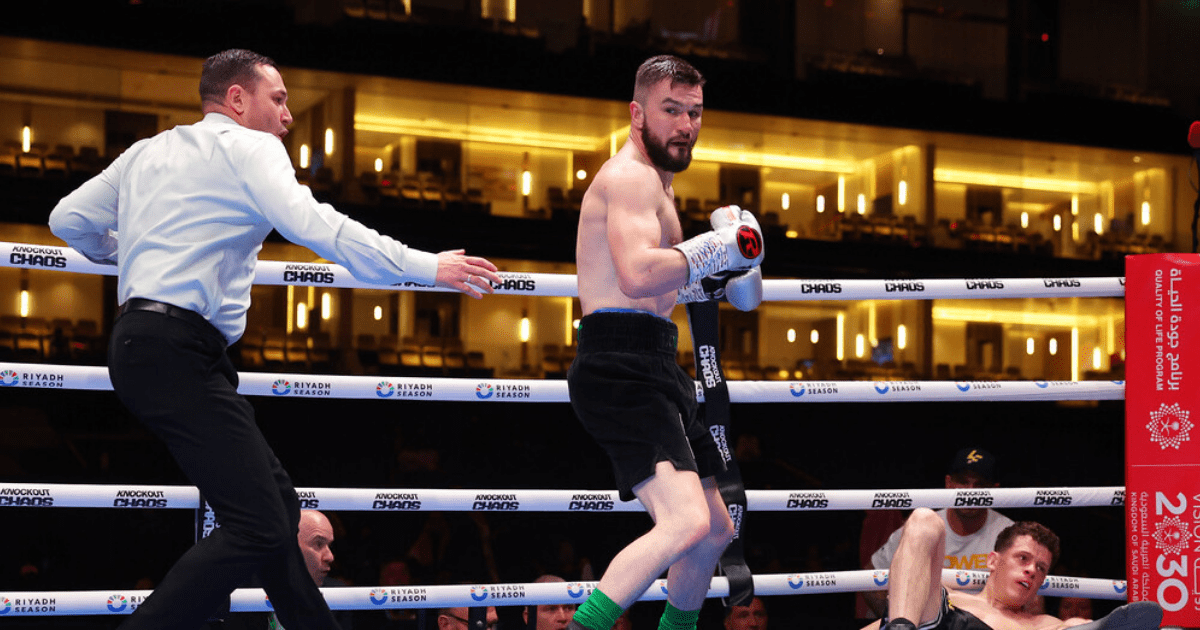From Holes in Kent to Knockout Victory
Louis Greene went from digging holes in Kent roads to securing a stunning first-round knockout on the Anthony Joshua vs Ngannou undercard in Saudi Arabia. The 31-year-old's journey took a surprising turn as he faced off against undefeated Liverpudlian Jack McGann in the preliminary fights.
Against All Odds
Despite being viewed as a massive underdog, Greene shocked many by delivering a knockout blow with a powerful right hook in the first round, leaving McGann down for the count. This victory marked a significant moment in Greene's career, prompting him to quit his day job in pursuit of climbing the super-welterweight ranks.
A Tribute to Family and Determination
Greene emotionally shared that he gave up his job and dedicated himself fully to training for this fight. He expressed gratitude towards his father for supporting him and guiding him away from a troubled path. Reflecting on his humble beginnings and the journey to success, Greene acknowledged the role his family played in his life.
Celebrating Success
Looking ahead, Greene plans to celebrate his triumph with a lively party upon his return to the UK. He looks forward to enjoying a well-deserved celebration with friends and family, reveling in his remarkable victory on the international stage.

Frequently Asked Questions
What are the most common mistakes that beginners make when they first start boxing?
Common mistakes include overextending punches, dropping the hands, ignoring defense, holding the breath, neglecting footwork, and focusing too much on power rather than technique. A coach with the right qualifications can help identify and correct mistakes before they become habitual.
Can I start boxing at any age?
Yes, as long you’re in good health and your doctor has given you clearance to begin boxing. Boxing is adaptable and can be customized to suit individuals of all ages and fitness levels.
What are the basic punches in boxing?
The fundamental punches in boxing include the jab, which is a quick, straight punch thrown with your lead hand; the cross, a powerful straight punch delivered with your rear hand; the hook, a semi-circular punch aimed at the side of your opponent’s head or body; and the uppercut, an upward strike aimed at the underside of your opponent’s chin or body.
How often should a beginner train in boxing?
Beginners will benefit from two to three sessions of boxing a week. Allowing time for rest, recovery and relaxation between workouts is important. As you acclimate to the sport and improve your fitness, you may gradually increase the frequency and intensity of your training.
What equipment do I need to start boxing?
For safety and to ensure effective training, you need the right equipment. This includes a pair of boxing gloves, hand wraps to protect your wrists and hands, a mouthguard, and headgear if sparring. In addition, athletic clothing and boxing boots are recommended for greater support and better movement.
What is amateur and professional Boxing?
Amateur-boxing is usually more concerned with the sport, focusing on points, technique and skill rather than knockouts. Often, the rounds are shorter and require protective headgear. Professional boxing, however, is a fulltime career, with longer rounds without headgear.
Statistics
- Beginner boxers tend to make the mistake of holding their breath in 70% of cases during their initial training sessions.
- Nearly 95% of boxing trainers agree that mental conditioning is just as important as physical training for beginners in the sport.
- Surveys reveal that close to 40% of new boxers join the sport for self-defense purposes rather than for competition or fitness.
- Studies suggest that about 30% of beginner boxers tend to neglect the importance of footwork in their initial training phase.
- Roughly 75% of beginners do not employ adequate defensive tactics in their first sparring sessions.
- Research indicates that nearly 70% of punches thrown by boxers during a match are jabs.
- Approximately 80% of boxing injuries occur during training, not in actual competition.
- Women are joining boxing in increasing numbers, rising by about 15% in the past decade, indicating growing gender diversity in the sport.
- It is estimated that 60% of beginner boxers do not use the correct size gloves, which can increase the risk of injury.
- Cardiovascular fitness improvements can be seen after just 12 weeks of consistent boxing training.
External Links
commandoboxing.com
boxingforlife.com
boxingnewsonline.net
sneakpunch.com
joinfightcamp.com
expertboxing.com
titleboxing.com
menshealth.com
globalfightcenter.com
proboxing-fans.com
How To
How to deliver an effective uppercut in boxing
The uppercut, when delivered accurately, can be a game-changing punch. Your rear hand should be lowered slightly, and your knees bent to lower your level. Your rear foot should be angled backwards and your hip thrust upwards as you move your rear hand upwards in a sweeping upward arc to your opponent’s face or body. Focus on your legs, core and lead hand, rather than your arm to generate force.

